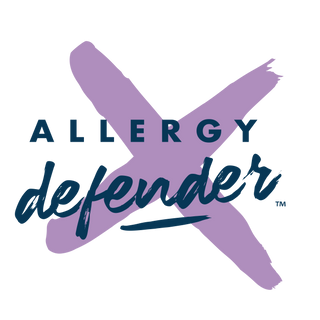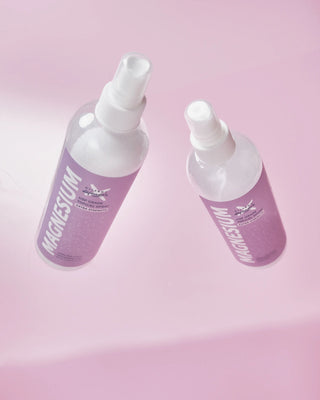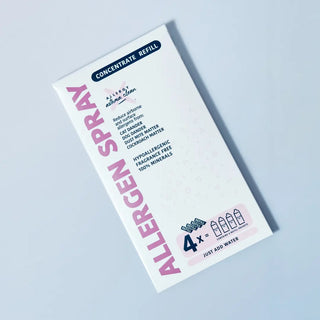

Allergens
Pet Dander
15 Minute Guide
Pet allergies are triggered by proteins in pet dander, saliva, and urine—not pet hair. These microscopic allergens cling to surfaces and float through the air, causing sneezing, itchy eyes, and respiratory issues. Managing exposure with regular cleaning, HEPA filtration, and a lab-verified allergen spray—like Allergy Asthma Clean Allergen Spray by Allergy Defender—can help reduce up to 99% of allergens on surfaces and 95% in the air. It’s a safe, effective way to control cat dander, dog allergens, and improve air quality without harsh chemicals.
Key Takeaways
- Pet dander, not pet hair, is the main trigger for allergies, carrying proteins that cause sneezing, watery eyes, and congestion.
- Even homes without pets can have cat dander and dog allergens, as these microscopic particles travel easily on clothing and air currents.
- Using a third-party lab verified allergen spray, such as Allergy Asthma Clean Allergen Spray by Allergy Defender, can significantly reduce airborne and surface allergens.
- Cleaning routines—like vacuuming with a HEPA filter, washing textiles in hot water, and decluttering—help minimize allergen buildup.
Pet Dander
If you're one of the millions of people who are allergic to pets, you know how difficult it can be to live with allergies. Pets are a part of many people's lives, and it's not always easy to give them up. However, there are ways that you can manage your allergy and still keep your pet. Pet allergies are triggered by proteins found in pet dander, saliva, and urine, not just pet hair which is a common misunderstanding. Pet dander is invisible, yet it can easily cling to carpets, furniture, walls, and other surfaces. Being lightweight, it can also float through the air and spread to other rooms in your home.

Are you allergic to your pet? The signs
Many people are surprised to find out that they are actually allergic to their beloved furry friend. The most common symptoms of pet allergies are sneezing, stuffy nose, coughing, wheezing, red, itchy, watery eyes, and rash or hives. If you experience any of these symptoms after coming into contact with your pet, It's likely you have an pet allergy and it's important to see an allergist for testing because it's very uncomfortable to live with pet allergies and you might be allergic to other allergens.
Take our Am I Allergic to My Dog Quiz or the Am I Allergic to My Cat Quiz?
How the body reacts to an allergen
Allergies are a complex immune response in which the body senses an otherwise harmless substance as a threat. When an allergen is encountered, the immune system responds by releasing histamines and other chemicals into the bloodstream, causing symptoms such as sneezing, wheezing, or hives. These reactions are intended to help eliminate the perceived threat from the body, but they can also cause serious health problems and discomfort for those who suffer from allergies. Ultimately, understanding how allergies work is critical for anyone who wants to live a healthy and comfortable life despite their allergic sensitivities.
Your mucous membranes and allergens
Mucous membranes are found throughout the body, lining various cavities and covering surfaces that come into contact with the external environment. One of their primary functions is to act as a barrier against harmful substances, such as bacteria and viruses. However, mucous membranes can also become irritated or inflamed in response to allergens, or pet allergens. When this happens, mucous membranes produce excess mucus in an attempt to flush out the allergen. This can lead to symptoms such as runny nose, watery eyes, and sneezing. In severe cases, mucous membrane inflammation can cause difficulty breathing.

What is pet dander?
The major cat allergen (Fel d 1) and dog allergen (Can f 1) are proteins found in your pet’s dander, saliva, and urine. A common misconception is that pet hair is the main allergen, but it's actually the dander that triggers allergic reactions. While pet hair itself isn't an allergen, it can carry other allergens like pollen and mold, making the situation worse.
Pet allergens are incredibly tiny, with the average size of a dander particle being just 2.5 microns—about one-tenth the diameter of a human hair. This makes them small enough to pass through HVAC filters and air purifiers, easily becoming airborne and inhaled. Once in the air, these tiny particles can linger for hours, triggering asthma attacks and other respiratory issues. What's even more concerning is that pet allergens are lightweight and can stick to clothes or shoes, quickly spreading from room to room. This means that even if you don’t have a pet, your home can still be filled with pet allergens.
Are pet allergens bad for your health?
What about high concentrations of pet allergens
Side effects of concentrated amounts of pet allergens can be serious and should not be taken lightly. Exposure to high concentrations of pet allergens, such as dander, may lead to a variety of adverse reactions in some individuals. In some cases, prolonged exposure to pet allergens may even contribute to the development of chronic health conditions such as asthma. In severe cases, an animal allergy can even trigger anaphylaxis, a potentially life-threatening reaction. Therefore, it is important for people with sensitivities to these substances to take steps to minimize their exposure whenever possible.
Can I have pet allergens in my house if I don't have a pet?
The short answer to this question is yes, you can have pet allergens in your house even if you don't own a pet. Pet allergens can travel through the air, and on clothing making it possible for these particles to accumulate in your home regardless of whether or not you own a pet. This is especially true if there are friends or relatives who own pets. So, while having a pet may increase your risk of experiencing allergic reactions to pet dander, it is important to remember that you can still encounter these triggers without having a dog or cat in your home. Did you know that 100% of households contain cat dander even if they don't own a cat?
All about pet allergy skin testing
Allergy skin testing is a way for your allergist to find out what substances are making you allergic. Allergy skin testing is also called skin prick test, intradermal test, or patch test. Allergy skin tests can be used to find out if you’re allergic to pet dander and more. Allergy skin tests are usually done by an allergist. The allergist will place a drop of a substance on your skin and then prick the surface of your skin with a needle. If you’re allergic to the substance, you’ll likely have a raised bump (wheal) and redness (flare) around the site where the prick occurred. If the wheal is large, it may itch. A positive allergy skin test means you may be allergic to that substance. Although, some people may find it uncomfortable to be pricked, allergy skin testing is generally safe.
All about pet allergy blood tests
Allergy blood tests are used to measure the body's immune response to certain allergens. These tests are typically conducted by drawing a sample of blood from the patient, which is then exposed to different potential allergens. If a specific allergen triggers an immune response, this will be detected in the blood sample via changes in various markers or proteins. Allergy blood tests are an important diagnostic tool for evaluating allergies and identifying the best course of treatment. They may involve a series of tests that are repeated over time to monitor whether a patient's condition is improving or worsening, and they can help to guide and personalize treatment plans through exposure therapy or other interventions. Overall, allergy blood tests provide valuable insight into allergic conditions and can help people live better lives with fewer allergy symptoms.


Pros and Cons of Taking Allergy Medication For Your Pet Allergy
When it comes to allergies, many people turn to medication as a way to ease their symptoms and feel better. However, despite its convenience and effectiveness, allergy medication also has its pros and cons. On the one hand, medications like antihistamines and decongestants can help to reduce inflammation and block histamine production, thus reducing the severity of allergy symptoms like runny noses, sneezing, and itchy eyes. Additionally, they are readily available from pharmacies or online, making them simple and convenient to obtain.
However, there are also some downsides to taking allergy medication. For one thing, some medications come with side effects such as drowsiness or dry mouth that can impact quality of life. In addition, pet dander and other common allergens may remain in homes where these medications have been used. This means that while they may provide temporary relief from allergies, they do not address the root cause of the problem. Ultimately, the decision whether or not to take allergy medication is a personal one that should be made based on each person's needs and preferences.
Allergy shots, immunotherapy, and Allergen Spray
While allergy shots are the most effective way to combat allergies, they are not the only option available. Some people may have a severe reaction to the shots, while others simply prefer not to receive them. There are a number of alternatives to allergy shots that can be just as effective in reducing or eliminating allergies. One option is oral immunotherapy, which involves taking gradually increasing doses of allergens in pill or liquid form. Another is sublingual immunotherapy which uses drops of allergens placed under the tongue. A third option is Allergen Spray that helps control pet allergens in the environment without you having to take daily pills or shots. With so many options available, there is no need to suffer from pet allergies any longer.
What is an allergen spray and can I use it in combination with allergy meds?
Allergen Spray are a life-saver for those who suffer from allergies to pets. These sprays help to reduce allergy symptoms by providing a barrier between you and the irritants in your home environment. Third-party lab verified to reduce allergens by up to 99% on surfaces and 95% of allergens in the air just by simply spray your house. So if you're looking to control your allergies without relying on medication, Allergen Spray is an excellent option. Just make sure to use it regularly to control pet allergens because after all, pet dander allergens are shed in your home daily!
How to control pet allergens in your home
Pet allergies can be a major nuisance, making it difficult to breathe or causing discomfort. To control pet allergens in your home, you will need to take a few key steps. The first is to limit your pet's exposure to certain areas of the house, such as bedrooms or where people tend to gather frequently. You should also routinely clean high-traffic areas such as the kitchen or living room. Vacuum carpets and upholstered furniture. Use a damp mop to remove pet dander and hair from kitchen and bath flooring. Use an allergen spray, regularly. Additionally, you should wash all textiles (clothing, bedding and towels) on a regular basis using a hypoallergenic detergent. By taking these steps, you can help minimize the amount of allergens in your home and improve your quality of life with a beloved pet.

5 steps to reduce pet dander in your home
1. Keep your pet out of the bedroom. This is probably the single most important thing you can do to help reduce your pet allergens. By keeping your pet out of the bedroom, you create a safe haven where you can retreat when symptoms start to flare up. Change into clean clothes before entering the room to reduce pet dander.
2. Vacuum at least twice a week, preferably daily. Vacuuming with a HEPA filter will help to remove pet dander from carpeting and upholstery. Be sure to vacuum regularly, even if you don't have visible signs of dirt or debris. As vacuuming/cleaning can release pet allergens back into the air, it is best to use the Allergen Spray after cleaning and vacuuming.
3. Wash items in hot water, above 130 degrees. Be sure to wash all of your clothing, bedding, and towels in hot water at least once a week. You may also want to consider using a hypoallergenic laundry detergent to further reduce the risk of triggering an allergy.
4. If you want to reduce the amount of pet dander in your home, one of the best things you can do is declutter. Removing unnecessary clutter also helps to minimize dust build-up, which in turn helps to keep pet dander at a minimum. And cleaning your home will be faster and easier.
5. Change your air filters at least once a month. If you have multiple pets, you may need to change your filter even more frequently, even every 2 weeks. Regularly changing your air filters is an important part of keeping your home clean and ensuring you can breathe easier with pet allergies. So if you have a furry friend, add the cost of air filters to you monthly budget. Install a high-rated MERV filter, 10 or above.
Common Questions
1. What is pet dander and how is it different from pet hair?
Pet dander is often confused with the hair or fur your furry friend leaves behind, but they're actually quite different! Pet dander refers to the tiny flakes of skin that animals shed regularly. While pet hair is visible and easier to clean up, dander is microscopic and can remain active for years in your home. Because it's so lightweight, it easily floats through the air and sticks to everything—your couch, curtains, bedding, and more. That's why even after vacuuming up all the pet hair, you might still experience allergy symptoms. Where there's pet hair, there's definitely dander hiding underneath!
2. How long does pet dander stay active on furniture?
Here's the frustrating truth: pet dander can remain active for years in its natural environment. It's incredibly persistent and doesn't just disappear on its own. This is why simply cleaning your couch once isn't enough—dander accumulates over time and continues to trigger allergies long after your pet has moved to another spot. The good news? With regular cleaning and the right products, you can neutralize that dander and finally get relief.
3. What type of vacuum is best for removing pet dander from furniture?
You'll want a vacuum cleaner with a HEPA (high-efficiency particulate air) filter—this is essential for effectively trapping and removing pet dander. Regular vacuums just don't cut it because they can actually blow dander back into the air! When you vacuum, don't hurry the process. Use the brush attachment to get into every crevice and cushion of your couch, paying extra attention to your pet's favorite spots. Think of it as giving your furniture the thorough cleaning it deserves!
4. Does steam cleaning kill pet dander on couches?
Steam cleaning can be a helpful addition to your cleaning routine! Consider steam cleaning once in a while to deep-clean your furniture. You can even buy a hand-held steamer for under $70, making it an affordable option. However, steam cleaning alone won't neutralize the allergens in pet dander—it's best used in combination with regular vacuuming and Allergy Asthma Clean Allergen Spray by Allergy Defender for maximum effectiveness.
5. What are the symptoms of pet dander allergies?
If you're allergic to pet dander, you know how miserable it can feel. We understand firsthand—our company was founded because of severe allergies and asthma. Common symptoms include:
- Sneezing and runny nose: Allergens in pet dander irritate your nasal passages, causing excessive sneezing and that annoying runny nose. These symptoms may occur shortly after contact with pets.
- Itchy or watery eyes: Redness, itching, and watery eyes happen when dander comes into contact with your eyes, triggering those allergic reactions.
- Coughing and wheezing: Exposure to pet dander can lead to coughing and wheezing, which can be particularly bothersome if you have asthma or other respiratory conditions.
If you're experiencing these symptoms, you're not alone—millions of people worldwide deal with pet dander allergies. The good news is there are effective ways to manage them so you can still enjoy your beloved pets!
6. Is leather or fabric furniture better for pet allergies?
If you're sick and tired of constantly battling pet dander on your couch, consider your furniture material carefully:
Leather furniture is a popular alternative to upholstered couches and chairs. Unlike fabric, leather doesn't provide a favorable environment for pet dander to accumulate. It's super easy to clean and can be wiped down regularly to remove any allergens that may be present. It might be expensive, but you'll never have to replace your couch again!
Microfiber furniture is another great option. This synthetic fabric is known for its durability and ease of cleaning. It has a tight weave that might help prevent pet hair and, in some cases, pet dander from penetrating the fabric. You can easily clean microfiber furniture with a vacuum or damp cloth—perfect for low-maintenance living!
Wood or metal furniture is also a good choice since these materials don't trap pet dander like upholstered furniture. They're easier to keep clean and allergen-free. Just note that wood furniture with intricate carvings or gaps may accumulate some pet dander and require regular cleaning.
7. Can pet dander travel to other rooms in my house?
Absolutely—and this is one of the most frustrating things about pet dander! Because it's so lightweight, pet dander easily floats in the air and transfers throughout your entire house. Your pet doesn't even need to visit a room for dander to end up there. This is why we recommend spraying Allergy Asthma Clean Allergen Spray by Allergy Defender everywhere in your living areas, not just where your pet hangs out. When you spray your couch, spray the whole room. Our spray is designed to be used in the air and on surfaces, giving you full-home coverage quickly. It's the only allergen spray that can be sprayed directly into the air, knocking everything out and providing immediate relief.
Remember: Allergy Asthma Clean Allergen Spray by Allergy Defender is made from 100% natural, clean mineral ingredients commonly found in the foods you eat daily—FDA GRAS pure sodium sesquicarbonate and FDA food grade mineral phosphate salts. No harsh chemicals, scents, or fragrances. It's safe for your whole family, pets included!
Learn more about your triggers
From dust mites to pet dander











